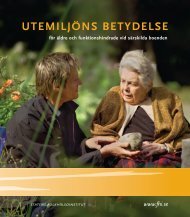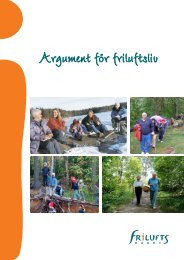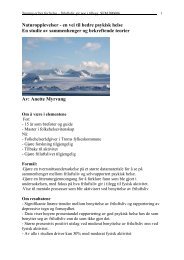Green Care: A Conceptual Framework - Frisk i naturen
Green Care: A Conceptual Framework - Frisk i naturen
Green Care: A Conceptual Framework - Frisk i naturen
Create successful ePaper yourself
Turn your PDF publications into a flip-book with our unique Google optimized e-Paper software.
the UK National Social Inclusion Programme; www.socialinclusion.org.<br />
uk and the Social Exclusion Task Force; http://www.cabinetoffice.gov.uk/<br />
social_exclusion_task_force.aspx).<br />
Social inclusion, on the other hand, refers to the processes by which people<br />
are enabled to participate in those key activities of the societies in which<br />
they live. Burchardt et al (2002) have proposed four key dimensions of<br />
social inclusion which they call consumption, production, social interaction<br />
and political engagement.<br />
■■<br />
■■<br />
■■<br />
■■<br />
Consumption is the idea of being able to buy the sorts of goods and<br />
services that other people can buy, and access the types of public<br />
services that other people can access.<br />
Production is the idea of being engaged in a socially valuable activity,<br />
including paid work, education/training, child care, other unpaid work<br />
and voluntary work.<br />
Social interaction refers to social networks and cultural identity.<br />
Political engagement is broadly conceived to include notions of<br />
self-determination, ‘having a say’, empowerment, being involved in<br />
campaigning organisations and so on.<br />
Social inclusion may be important as a concept within green care for<br />
describing and exploring its benefits. Sempik et al (2005) have used the<br />
framework of social inclusion, as postulated by Burchardt et al (2002),<br />
in their study of Social and Therapeutic Horticulture (STH). They have<br />
argued that STH enables social inclusion through providing meaningful<br />
activities for participants (production) in an environment that is deliberately<br />
structured to promote social interaction and maximise social opportunities;<br />
STH projects frequently involve clients in the organisation and running of<br />
the project and in decision-making (political engagement); and often they<br />
provide access to goods and services (consumption) that clients would<br />
otherwise be unable to afford, for example, high quality (organic) food and<br />
the opportunity to participate in gardening, education and training. Such an<br />
analysis could be extended to other forms of green care.<br />
Other green care services which include involvement with animals or<br />
livestock also add a further dimension to social inclusion. It is hypothesized<br />
that social support acting as a buffer against stress responses or illness<br />
105















